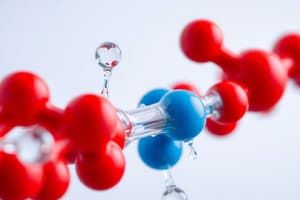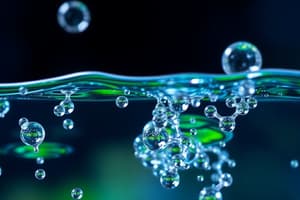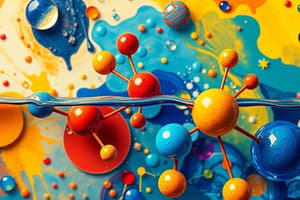Podcast
Questions and Answers
Which of these describes the process of forming a polymer?
Which of these describes the process of forming a polymer?
- Increasing the number of carbon atoms
- Adding water molecules
- Removing water molecules (correct)
- Breaking down into monomers
Which of the following statements is TRUE about isotopes?
Which of the following statements is TRUE about isotopes?
- They have the same number of protons and neutrons.
- They have the same chemical properties. (correct)
- They have different atomic numbers.
- They have the same mass number.
Which type of bond is characterized by the sharing of electrons?
Which type of bond is characterized by the sharing of electrons?
- Van der Waals interaction
- Covalent bond (correct)
- Ionic bond
- Hydrogen bond
Which of the following correctly describes the relationship between a carbonyl group and ketones?
Which of the following correctly describes the relationship between a carbonyl group and ketones?
What is the basic building block of carbohydrates?
What is the basic building block of carbohydrates?
Which of the following is NOT a function of lipids?
Which of the following is NOT a function of lipids?
Which macromolecule is a polymer of amino acids?
Which macromolecule is a polymer of amino acids?
Which of the following structures is NOT found in a nucleotide?
Which of the following structures is NOT found in a nucleotide?
What is the function of DNA in protein synthesis?
What is the function of DNA in protein synthesis?
Which of the following is NOT a pyrimidine base found in nucleic acids?
Which of the following is NOT a pyrimidine base found in nucleic acids?
What is the main difference between DNA and RNA?
What is the main difference between DNA and RNA?
Which of the following is the correct order of steps involved in protein synthesis?
Which of the following is the correct order of steps involved in protein synthesis?
Which of the following statements best describes the function of ATP?
Which of the following statements best describes the function of ATP?
Which type of bond is responsible for the secondary structure of proteins?
Which type of bond is responsible for the secondary structure of proteins?
Which of the following conditions is associated with a misfolded protein?
Which of the following conditions is associated with a misfolded protein?
Which of the following is a characteristic of a saturated fat?
Which of the following is a characteristic of a saturated fat?
Which type of macromolecule is primarily responsible for cell membrane structure?
Which type of macromolecule is primarily responsible for cell membrane structure?
What is the prefix for a carbon skeleton with five carbons?
What is the prefix for a carbon skeleton with five carbons?
Which of the following is NOT a property of water?
Which of the following is NOT a property of water?
What is the functional group that characterizes aldehydes and ketones?
What is the functional group that characterizes aldehydes and ketones?
What determines the reactivity of an atom?
What determines the reactivity of an atom?
What is the suffix for a carbon skeleton with a double bond?
What is the suffix for a carbon skeleton with a double bond?
Which type of macromolecule serves as the primary energy storage molecule in living organisms?
Which type of macromolecule serves as the primary energy storage molecule in living organisms?
Which of the following is considered a compound?
Which of the following is considered a compound?
Which of these is NOT a characteristic of a buffer?
Which of these is NOT a characteristic of a buffer?
Flashcards
Aldehyde Suffix
Aldehyde Suffix
The suffix for an aldehyde is 'al'.
Phosphate in ATP
Phosphate in ATP
Phosphate groups are crucial for ATP, the energy currency of the cell.
Macromolecule - Nucleic Acids
Macromolecule - Nucleic Acids
Nucleic acids store and transmit genetic information in DNA and RNA.
Energy Storage Macromolecule
Energy Storage Macromolecule
Signup and view all the flashcards
Definition of Molecules
Definition of Molecules
Signup and view all the flashcards
What is a Buffer?
What is a Buffer?
Signup and view all the flashcards
Properties of Water
Properties of Water
Signup and view all the flashcards
What is Valence?
What is Valence?
Signup and view all the flashcards
Electrons
Electrons
Signup and view all the flashcards
Ionic bond
Ionic bond
Signup and view all the flashcards
Covalent bond
Covalent bond
Signup and view all the flashcards
Isotopes
Isotopes
Signup and view all the flashcards
Half-life
Half-life
Signup and view all the flashcards
Hydrophilic
Hydrophilic
Signup and view all the flashcards
Hydrophobic
Hydrophobic
Signup and view all the flashcards
Nucleotide
Nucleotide
Signup and view all the flashcards
Protein synthesis
Protein synthesis
Signup and view all the flashcards
Monosaccharide
Monosaccharide
Signup and view all the flashcards
Polysaccharide
Polysaccharide
Signup and view all the flashcards
Amino acids
Amino acids
Signup and view all the flashcards
Cholesterol types
Cholesterol types
Signup and view all the flashcards
Dehydration synthesis
Dehydration synthesis
Signup and view all the flashcards
Hydroxyl group
Hydroxyl group
Signup and view all the flashcards
Study Notes
Organic Molecules
- Aldehyde Suffix: Al
- Important Phosphate Group: ATP
- Information Molecule: Nucleic acids (DNA and RNA)
- Energy Storage Molecule: Lipids
- Definition of Molecules: Two or more atoms held together by covalent bonds (e.g., H₂O)
- Definition of Compound: Two or more elements chemically combined (e.g., NaCl)
- Bonding Atoms: Electrons
- Reactivity: Determined by available bonding electrons
- Five Carbon Skeleton Prefix: Pent
- Ketones and Aldehydes Functional Group: Carbonyl
- Water Properties: Cohesion, surface tension, high specific heat, ice density, dissociation, polar covalent bonds
Water Properties
- Hydrogen Bonding: Resulted from water's polarity
- Cohesion: Hydrogen bonds holding substances together
- Surface Tension: Force to stretch/break liquid surface
- High Specific Heat: Water resists temperature change (energy to change)
- Ice Density: Hydrogen bonding makes ice less dense
- Water Dissociation: Water as a solvent, cells are mostly water (70-90%)
- pH and Concentration: Higher concentration = lower pH
Acids, Bases, & Buffers
- Buffer: Substance minimizing pH changes
Atoms and Bonds
- Valence: Number of electrons needed to fill outer shell
- Prefixes for Carbon Skeletons:
- One carbon (Met)
- Two carbons (Eth)
- Three carbons (Prop)
- Four carbons (But)
- Suffixes for Carbon Skeletons (Single and Double Bonds):
- Single bonds (Ane)
- Double bonds (Ene)
- Isomers: Compounds with identical formulas and different structures
- Matter: Anything with mass and volume
- Mass: Amount of matter in an object
- Atomic Structure: Atoms composed of subatomic particles (protons, neutrons, electrons)
- Nucleus: Contains protons and neutrons
- Electrons: Orbit outside the nucleus
- Similar Properties: Elements in a vertical column (group)
- Neutral Atom: Equal number of protons and electrons
- Neutron Calculation: Atomic mass - Atomic number
- Isotopes: Same number of protons, different number of neutrons
- Isotope Properties: Same chemical properties due to same electron number
- Isotopes and Mass Number: Different mass numbers
- High Specific Heat (water): Water takes longer to heat than air
- Oxidation: Loss of an electron
- Reduction: Gain of an electron
- Nonpolar Bonds: Same electronegativity
- Polar Bonds: Different electronegativity
- Half-Life: Time for half of a substance to decay radioactively
- Electronegativity: Atom's ability to attract electrons
- Covalent Bond: Sharing of electrons
- Ionic Bond: Attraction of opposite charges
- Hydrogen Bond: Sharing of hydrogen atom
- Van Der Waals Interaction: Interaction of electron clouds
- Hydrocarbons: Chains of carbon and hydrogen
- Alcohols (Hydroxyl Groups): Polar covalent bonds, -OH
- Carbonyl Group: Oxygen atom with double bond, =CO, ketones and aldehydes
- Aldehyde (Carbonyl Group): Carbonyl group on end of skeleton
- Ketone (Carbonyl Group): Carbonyl group between two carbons
- Carboxyl Group: Carbon with double-bonded oxygen and hydroxyl group (O=C-OH)
- Amino Group: Nitrogen attached to two hydrogens (-NH₂)
- Sulfhydryl Group (Thiols): Sulfur bonded to hydrogen (-SH)
- Phosphate Groups: Phosphorus bonded to four oxygens
- Methyl Group: Stripped hydrogen from methane (-CH₃)
- Methyl Group Properties: Hydrophobic, nonpolar covalent bonds
Macromolecules
- Polymer Macromolecule Types: Carbohydrates, proteins, nucleic acids
- Polymer Breakdown: Hydrolysis (addition of water)
- Dehydration: Formation of water
- Monosaccharide Formula: CH₂O
- Monosaccharide Example: Glucose (C₆H₁₂O₆)
- Disaccharides: Two monosaccharides joined by dehydration
- Polysaccharides Function: Storage and structure
- Animal Polysaccharide: Glycogen
- Plant Cell Wall Carbohydrate: Cellulose
- Cellulose Function: Structure
- Fungi Cell Wall Carbohydrate: Chitin
- Lipid Functions: Energy storage, heat insulation, hormones, membranes
- Triglyceride Types: Glycerol and fatty acids
- Saturated Fats: Single covalent bonds
- Unsaturated Fats: Double covalent bonds
- Triglyceride Carbon Count: Usually ~ 4
- Phospholipids: Hydrophilic head, hydrophobic tail
- Cholesterol Types: HDL (good), LDL (bad)
- Proteins: Polymers of amino acids
- Protein Functions: Structural support, storage, enzymes
- Blood Buffer: Carbonic acid
- Primary Structure Protein Condition: Sickle cell anemia
- Secondary Structure Protein Condition: Mad cow's disease
- Primary Structure Function: Determines shape & identity
- Primary Structure Definition: Sequence of amino acids
- Sickle Cell Cause: Incorrect amino acid placement
- Secondary Structure Function: Coils and folds
- Mad Cow Cause: Misfolded prion proteins
- Protein Composition: Polypeptides
- Quaternary Structure: Two+ polypeptide chains (e.g., collagen)
- Protein Denaturation: Unfolding by chemicals/temperature
- Nucleotide Parts: Sugar, phosphate, nitrogen base
- Pyrimidines: Cytosine, thymine, uracil
- Purines: Adenine, Guanine
- DNA Bases: Adenine, thymine, guanine, cytosine
- RNA Bases: Adenine, uracil, guanine, cytosine
- Deoxyribose: Missing an oxygen in DNA
- DNA Acronym: Deoxyribonucleic acid
- RNA Acronym: Ribonucleic acid
- DNA Discoverer: Rosalind Franklin
- DNA Replication: DNA copying in mitosis/meiosis
- Protein Synthesis: DNA to RNA to Protein
- Ribosomes Composition: Protein and RNA
- Ribosome Function: Protein synthesis
- ATP Acronym: Adenosine triphosphate
- ATP Function: Energy carrier for cellular respiration
- Double Helix: Two polynucleotide strands
- Nucleic Acid Coenzymes: FAD, NAD
Studying That Suits You
Use AI to generate personalized quizzes and flashcards to suit your learning preferences.




